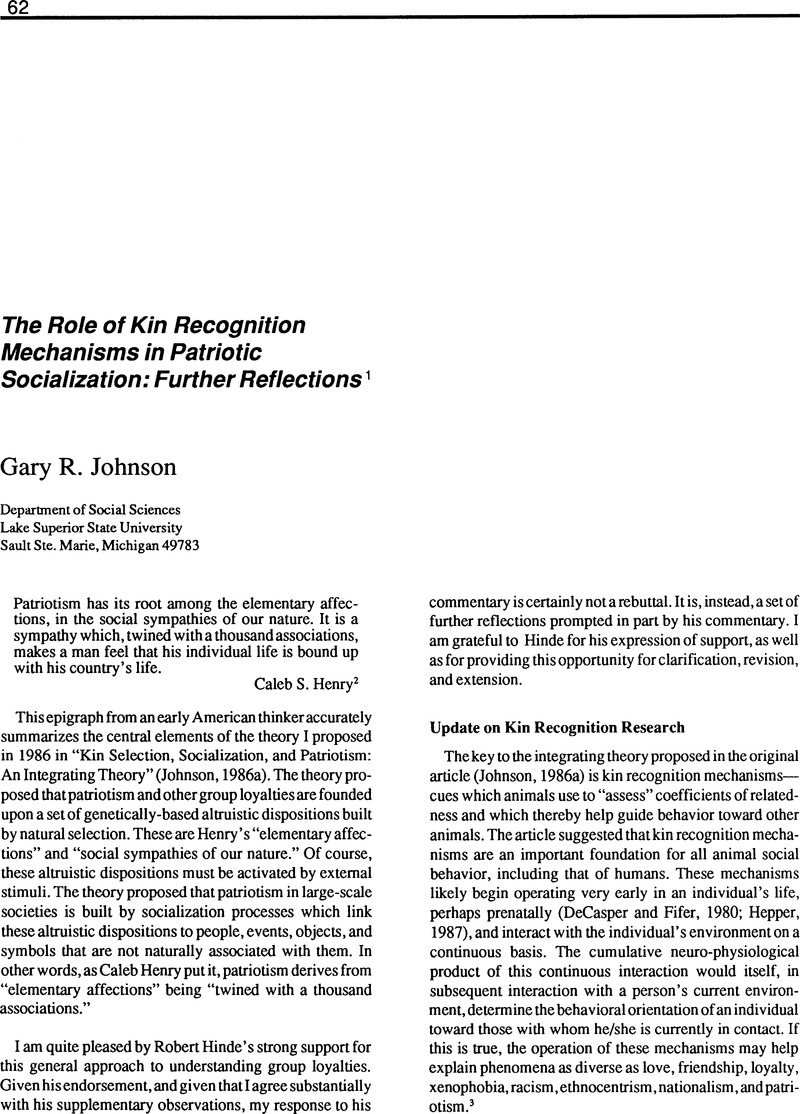Crossref Citations
This article has been cited by the following publications. This list is generated based on data provided by Crossref.
Ross, Marc Howard
1991.
The Role of Evolution in Ethnocentric Conflict and Its Management.
Journal of Social Issues,
Vol. 47,
Issue. 3,
p.
167.
Flohr, Anne Katrin
1994.
Fremdenfeindlichkeit.
p.
11.
Wong, Yuwa
1994.
Impotence and Intransigence: State Behavior in the Throes of Deepening Global Crisis.
Politics and the Life Sciences,
Vol. 13,
Issue. 1,
p.
3.
Cronk, Lee
1994.
EVOLUTIONARY THEORIES OF MORALITY AND THE MANIPULATIVE USE OF SIGNALS.
Zygon®,
Vol. 29,
Issue. 1,
p.
81.
Flohr, Anne Katrin
1994.
Fremdenfeindlichkeit.
p.
253.
Cronk, Lee
1995.
Is there a role for culture in human behavioral ecology?.
Ethology and Sociobiology,
Vol. 16,
Issue. 3,
p.
181.
Holper, Joseph John
1996.
Kin Term Usage in The Federalist: Evolutionary Foundations of Publius's Rhetoric.
Politics and the Life Sciences,
Vol. 15,
Issue. 2,
p.
265.
Hinde, Robert
1997.
Aggression.
p.
177.
Hinde, R. A.
1997.
War: some psychological causes and consequences.
Interdisciplinary Science Reviews,
Vol. 22,
Issue. 3,
p.
229.
Johnson, Gary R.
1997.
The Architecture of Ethnic Identity.
Politics and the Life Sciences,
Vol. 16,
Issue. 2,
p.
257.
Salmon, Catherine A.
1998.
The Evocative Nature of Kin Terminology in Political Rhetoric.
Politics and the Life Sciences,
Vol. 17,
Issue. 1,
p.
51.
Qirko, Hector
2004.
Altruistic Celibacy, Kin‐Cue Manipulation, and The Development of Religious Institutions.
Zygon®,
Vol. 39,
Issue. 3,
p.
681.
2005.
L'Autre.
p.
355.
Qirko, Hector N.
2009.
ALTRUISM IN SUICIDE TERROR ORGANIZATIONS.
Zygon®,
Vol. 44,
Issue. 2,
p.
289.
Cronk, Lee
and
Gerkey, Drew
2012.
Oxford Handbook of Evolutionary Psychology.
p.
463.
Qirko, Hector N.
2013.
Induced Altruism in Religious, Military, and Terrorist Organizations.
Cross-Cultural Research,
Vol. 47,
Issue. 2,
p.
131.
Qirko, Hector
2014.
Organizational structures and practices are better predictors of suicide terror threats than individual psychological dispositions.
Behavioral and Brain Sciences,
Vol. 37,
Issue. 4,
p.
374.
Kumari, Bindu
Nara, Sushma
and
Sangwan, Neetu
2024.
Psychology of Sexuality & Mental Health Vol. 1.
p.
103.
Heschl, Adolf
2024.
Evolutionäre Sozialwissenschaften.
p.
131.



